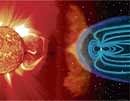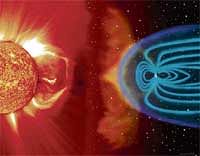

Twenty years ago, on March 13, 1989, Quebec province of Canada suffered a blackout because of transformer failure. It took more than nine hours to revive power transmission and that too with increased load. There was a colossal wastage of money because the transformers were large and expensive, costing about 10 million dollars. It remained a mystery as to what caused such havoc.
Solar physicists call such disturbances ‘space weather’ phenomenon. During a space weather event, huge amount of mass and energy are violently released from the sun. As a result, the conditions between the sun and the earth change abruptly due to the change in charge particle concentration and magnetic field.
Trigger power system failures
Space weather disturbances cause large amount of direct current in the transmission lines, eventually causing power system failures.
The sun expels one million tonnes of matter per second into space in the form of solar wind. Solar wind consists mainly of charged particles (or plasma) and it is continuously flowing outwardly from the sun. The space between the sun and the earth is full of charged particles, so it is no longer a vacuum. Solar wind was first predicted by Prof Eugene Parker in 1958.
Later on, the existence of solar wind was confirmed by way of satellite observations.
The moment solar wind hits the earth’s magnetic field, some of the charged particles flow into the earth’s upper atmosphere. These charged particles collide easily with the molecules of the upper atmosphere causing colourful displays or auroras in the sky.
These auroras are mainly seen during the night in the earth’s polar regions, drawing visitors from all over the world. In the last 20 years, the number of aurora visitors has increased.
Effects of solar storms, flares
Solar storms like Coronal Mass Ejections (CMEs) and solar flares usually occur when the sun is active. Solar storms can have various harmful effects on human lives. A solar storm can disturb radio signals and therefore affects cell phones, televisions, air traffic controls and Global Positioning Systems (GPS).
It can harm the sensitive electronics onboard satellite. A space weather event can even endanger the lives of astronauts. The effect of space weather can be seen on migratory animals too.
Pigeons, dolphins and whales have the ability to sense the magnetic field, like a compass. During a space weather event, their navigational abilities are degraded because of the changes in the earth’s magnetic field.
To keep us away from such hazards, forecasting space weather is very important.
Intense magnetic structures
One of the interesting features on the sun are sunspots. The sunspots are large, intense magnetic structures on the sun’s surface. Sunspots tend to occur in pairs. A pair of sunspots has opposite magnetic polarities, just like a bar magnet.
The magnetic field in the sunspot is more than 1,000 times stronger than the earth’s magnetic field.
It is well known that the number of sunspots vary periodically with time, mainly constituting a 11-year solar cycle. The number of sunspots peaks when the sun is active.
Scientists call this phase solar maximum, and in fact most of the storms occur during this phase. The sunspot cycle is considered the main source of space weather phenomenon.
In order to forecast space weather, solar scientists keep a close watch on the number of sunspots.
Various space agencies such as European Space Agency (ESA), Japanese Aerospace Exploration Agency (JAXA) and NASA, grant projects to understand space weather and related studies. ISRO is also planning a solar mission ‘Aditya’ which is scheduled for launch in 2012.
It will observe solar flares and CMEs and provide unprecedented data to the solar scientists.
NASA’s new Solar Terrestrial Relations Observatory (STEREO) mission is currently observing the sun with two satellites. The main objective of the mission is to make better progress in space weather forecasting. With the help of these two satellites, scientists will observe the 3D view of the CMEs and able to forecast space weather in a much better way.
(The author is a solar scientist at the Kwasan & Hida Observatories, Kyoto University, Japan)